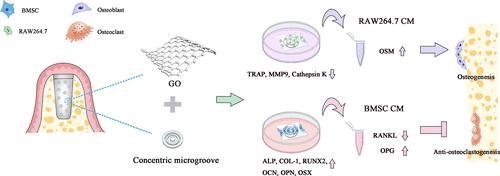当前位置:
X-MOL 学术
›
ACS Appl. Mater. Interfaces
›
论文详情
Our official English website, www.x-mol.net, welcomes your
feedback! (Note: you will need to create a separate account there.)
Graphene Oxide-Modified Concentric Microgrooved Titanium Surfaces for the Dual Effects of Osteogenesis and Antiosteoclastogenesis
ACS Applied Materials & Interfaces ( IF 8.3 ) Pub Date : 2022-12-01 , DOI: 10.1021/acsami.2c14271 Hong Wang 1, 2 , Yingzhen Lai 2, 3 , Zeyu Xie 2, 3 , Yanyin Lin 2, 3 , Yihuang Cai 2, 3 , Zhiqiang Xu 4 , Jiang Chen 1
ACS Applied Materials & Interfaces ( IF 8.3 ) Pub Date : 2022-12-01 , DOI: 10.1021/acsami.2c14271 Hong Wang 1, 2 , Yingzhen Lai 2, 3 , Zeyu Xie 2, 3 , Yanyin Lin 2, 3 , Yihuang Cai 2, 3 , Zhiqiang Xu 4 , Jiang Chen 1
Affiliation

|
Surface modification is an effective method to resolve the biocompatibility, mechanical, and functional issues of various titanium implant materials. Therefore, many researchers have modified the implant surface to promote the osseointegration of the implant and improve the implant survival rate. In this study, we used photolithography to construct concentric microgrooves with widths of 10 μm and depths of 10 μm, to produce an osteon-mimetic concentric microgrooved titanium surface that was further modified with graphene oxide by silanization (GO-CMS). The modified surface had great biocompatibility and promoted the proliferation of bone marrow-derived mesenchymal stem cells (BMSCs) and RAW264.7 macrophages. The concentric microgrooves on the titanium surface guided cell migration, altered actin cytoskeleton, and caused the cells to arrange in concentric circles. The titanium surface of the GO-modified osteon-mimetic concentric microgrooves promoted the osteogenic differentiation of BMSCs and inhibited the osteoclastogenic differentiation of RAW264.7 cells. Subsequently, we constructed an indirect coculture system and found that RAW264.7 cells cultured on a GO-CMS material surface in a BMSC-conditioned medium (BCM) decreased receptor activator of nuclear factor-κB ligand (RANKL) secretion and increased OPG secretion and also that the BCM inhibited osteoclastogenic differentiation. Additionally, the secretion of OSM increased in BMSCs cultured in RAW264.7-conditioned medium (RCM) in the GO-CMS group, which in turn promoted the osteogenic differentiation of BMSCs. In conclusion, the titanium surface of GO-modified osteon-mimetic concentric microgrooves had dual effects of osteogenesis and antiosteoclastogenesis under single and coculture conditions, which is beneficial for implant osseointegration and is a promising method for the future direction of surface modifications of implants.
中文翻译:

氧化石墨烯修饰的同心微槽钛表面对成骨和抗破骨细胞生成的双重作用
表面改性是解决各种钛植入材料的生物相容性、力学和功能问题的有效方法。因此,许多研究者对种植体表面进行修饰,以促进种植体的骨整合,提高种植体成活率。在这项研究中,我们使用光刻技术构建宽度为 10 μm 和深度为 10 μm 的同心微槽,以产生仿骨同心微槽钛表面,并通过硅烷化 (GO-CMS) 用氧化石墨烯进一步改性。修饰后的表面具有良好的生物相容性,可促进骨髓间充质干细胞(BMSCs)和RAW264.7巨噬细胞的增殖。钛表面的同心微槽引导细胞迁移,改变肌动蛋白细胞骨架,并使细胞排列成同心圆。GO修饰的拟骨同心微槽的钛表面促进BMSCs的成骨分化并抑制RAW264.7细胞的破骨细胞分化。随后,我们构建了一个间接共培养系统,发现在 BMSC 条件培养基(BCM)中的 GO-CMS 材料表面培养的 RAW264.7 细胞减少了核因子-κB 配体受体激活剂(RANKL)的分泌,增加了 OPG 的分泌,还表明 BCM 抑制破骨细胞分化。此外,GO-CMS组在RAW264.7条件培养基(RCM)中培养的BMSCs中OSM的分泌增加,进而促进BMSCs的成骨分化。综上所述,
更新日期:2022-12-01
中文翻译:

氧化石墨烯修饰的同心微槽钛表面对成骨和抗破骨细胞生成的双重作用
表面改性是解决各种钛植入材料的生物相容性、力学和功能问题的有效方法。因此,许多研究者对种植体表面进行修饰,以促进种植体的骨整合,提高种植体成活率。在这项研究中,我们使用光刻技术构建宽度为 10 μm 和深度为 10 μm 的同心微槽,以产生仿骨同心微槽钛表面,并通过硅烷化 (GO-CMS) 用氧化石墨烯进一步改性。修饰后的表面具有良好的生物相容性,可促进骨髓间充质干细胞(BMSCs)和RAW264.7巨噬细胞的增殖。钛表面的同心微槽引导细胞迁移,改变肌动蛋白细胞骨架,并使细胞排列成同心圆。GO修饰的拟骨同心微槽的钛表面促进BMSCs的成骨分化并抑制RAW264.7细胞的破骨细胞分化。随后,我们构建了一个间接共培养系统,发现在 BMSC 条件培养基(BCM)中的 GO-CMS 材料表面培养的 RAW264.7 细胞减少了核因子-κB 配体受体激活剂(RANKL)的分泌,增加了 OPG 的分泌,还表明 BCM 抑制破骨细胞分化。此外,GO-CMS组在RAW264.7条件培养基(RCM)中培养的BMSCs中OSM的分泌增加,进而促进BMSCs的成骨分化。综上所述,











































 京公网安备 11010802027423号
京公网安备 11010802027423号